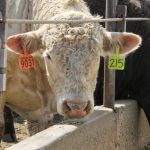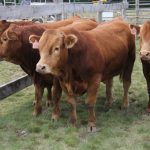For the week ending August 23, Western Canadian feeder cattle markets traded $5 to $10 higher on average compared to seven days earlier. In some locations such as Lethbridge, larger packages of quality yearlings traded $10 to as much as $20/cwt higher.
Tag Archives calves

Klassen: Feeder market makes another leg higher

Klassen: Strong demand supports feeder complex
For the week ending August 9, Western Canadian feeder cattle markets traded $5 to $10 higher on average. Many weight categories notched fresh record highs. Ontario demand was evident across western Canada for calves and yearlings.

Klassen: Feeder market in price discovery mode
For the week ending August 2, Western Canadian feeder cattle markets traded steady to as much as $10 higher. Quality yearling packages off grass were up as much as $15 in some cases. Prices for similar weight cattle were quite variable across the Prairies, which made the market hard to define. The market appears to be in price discovery mode for the grass yearling market.

Klassen: Lower U.S. calf crop supports Canadian feeder cattle market
For the week ending July 26, Western Canadian feeder cattle markets were relatively unchanged from seven days earlier. Yearlings off grass weighing 900 pounds plus were very strong and may have been up $3 to $5 from the previous week.

Klassen: Lower feed grain prices set to enhance feeder cattle prices
For the week ending July 19, Western Canadian feeder cattle markets were unchanged from the previous week, although volumes were limited.

Greater feed efficiency in calves possible through controlled creep feeding
Advantage Feeders founder talks rumen development, financial benefits of creep feeding at Ag in Motion 2025
Gerard Roney, founder of Advantage Feeders in Australia, spoke at Ag in Motion 2025 about using controlled creep feeding to develop a calf's rumen, allowing for better uptake of energy and protein at a younger age.

Klassen: Western Canadian calf markets surge on New World screwworm fears
For the week ending July 12, Western Canadian yearling markets traded steady to $5 higher compared to seven days earlier. Calves weighing 550-800 pounds were quoted $5 lower to as much as $10 higher.

Klassen: Feeder market may have overextended to the upside
For the week ending July 4, there were no feeder cattle sales in Western Canada due to holidays on July 1 and July 4. Major auction markets in the U.S. were also closed or had limited numbers on offer. Prices quoted from south of the border were steady to $4 higher on average but the market was hard to define.

Klassen: Feeder market eyes deferred delivery prices
For the week ending June 28, Western Canadian feeder cattle markets were relatively unchanged compared to seven days earlier. Volumes moving through the ring were limited and the quality was quite variable.

Klassen: Feeder market rally stalls on softer fed cattle market
For the week ending June 21, Western Canadian feeder cattle prices were unchanged to $10 lower on average compared to seven days earlier. However, prices for August and September delivery were unchanged from the previous week.
